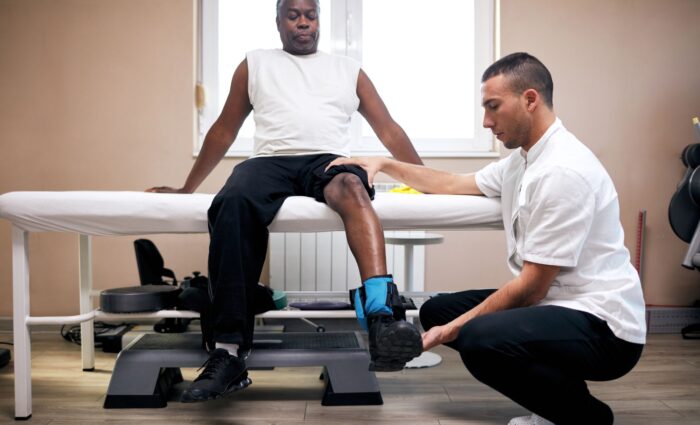Recovering from an injury isn’t just about letting time pass. It’s about knowing when to start physical therapy after injury to help your body heal safely and efficiently. The right timing can make a big difference in how well your muscles, joints, and tissues recover. Starting therapy too early strains healing tissues, while delaying it causes stiffness, weakness, and chronic pain that hinders recovery. Understanding when and how to begin treatment ensures your recovery process stays on track from the very beginning.
Physical therapy focuses on restoring mobility, rebuilding strength, and preventing long-term complications. Whether your sports injuries came from an accident or surgery, the licensed physical therapists at Rego Park Diagnostic & Treatment Center can assess your condition and design a personalized recovery plan. They’ll guide you through a customized treatment program to help you heal safely and regain strength. This article explains when to begin therapy and why early movement, under professional care, leads to faster, safer recovery.
Why Timing Matters in Physical Therapy
Every injury follows a biological healing process that unfolds in three stages: inflammation, repair, and remodeling.
- Inflammation (Days 1–5): The body sends blood and nutrients to protect the damaged area, often causing swelling and pain.
- Repair (Days 5–21): Tissues begin rebuilding; light movement and controlled therapy become beneficial.
- Remodeling (3 weeks–months): Strength and flexibility exercises restore normal movement and prevent scar tissue buildup.
When therapy is aligned with the body’s natural healing stages, outcomes tend to improve. Research shows that beginning physical therapy early leads to better functional recovery and faster mobility. It also improves strength and balance without increasing the risk of re-injury. For example, a study on knee rehabilitation found that patients who started therapy early achieved better functional outcomes than those who delayed treatment.
How Soon Should You Start Physical Therapy?
There’s no one-size-fits-all answer to when to start physical therapy after injury. It depends on the type, location, and severity of your condition. Still, most physical therapists agree that the sooner you begin safe physical activity and guided movement, the better your long-term outcome will be.
Below is a general timeline for when most people can start physical therapy after common injuries:
| Injury Type | Average Start Time | Key Focus During Early PT |
| Minor sprain or strain | Within 2–3 days | Gentle range of motion and blood flow improvement |
| Moderate muscle or tendon injury | 3–5 days | Reduce swelling, begin light activation exercises |
| Post-surgical recovery (ACL, rotator cuff, etc.) | After doctor clearance (usually 1–2 weeks) | Protect healing tissues, begin guided mobility |
| Fracture or broken bone | After cast removal or bone stability confirmed | Rebuilding strength and motion |
| Chronic or long-ago injury | Start anytime after assessment | Address stiffness, scar tissue, and muscle weakness |
The safest approach is to consult your doctor or licensed physical therapist first. They’ll evaluate the injured area, pain level, and healing progress before designing a customized treatment plan. Starting too soon on your own can increase pain or slow the healing process.
Signs You’re Ready to Begin Physical Therapy
Recognizing when your body is ready to begin therapy helps you transition from rest to recovery safely. Most patients notice specific changes that signal it’s time to move forward.
Here are key indicators you may be ready to start physical therapy:
- Pain and swelling have decreased: The initial inflammation has subsided, and you can tolerate gentle movement.
- You can move without sharp or increased pain: Mobility should feel stiff but manageable, not severely painful.
- Your doctor or surgeon has cleared you: Always follow professional advice if you’ve undergone surgery.
- You can bear light weight or perform daily motions: Even partial range of motion or minimal resistance means the body is healing.
Benefits of Starting Physical Therapy Early
Starting physical therapy early offers more than just faster recovery; it also enhances your overall health. It can change the quality of your long-term health and mobility. Early intervention restores muscle function and keeps the nervous system engaged in the healing process.
Here’s how early physical therapy helps:
- Prevents stiffness and scar tissue: Gentle stretching and guided motion keep joints flexible and promote healthy tissue remodeling.
- Improves blood flow and healing: Movement increases circulation, delivering oxygen and nutrients to the injured tissues.
- Reduces chronic pain risk: Early therapy retrains your muscles and nerves, reducing sensitivity that leads to lasting discomfort.
- Shortens recovery time: Early initiation of physical therapy is associated with improved functional outcomes and shorter rehabilitation time, especially when compared to significant delays.
- Promotes mental confidence: Engaging with a therapist helps you regain trust in your body and overcome the fear of re-injury.
With consistent therapy sessions, many patients return to normal activities sooner. They maintain muscle strength and avoid long-term stiffness or weakness.
Risks of Delaying Physical Therapy
While rest is essential early on, waiting too long to start physical therapy can make recovery more difficult. Once the body moves past the initial healing phase, it becomes crucial to achieve full recovery. Unused muscles and joints begin to lose strength and flexibility, which slows overall progress.
Delaying treatment often results in muscle atrophy, joint stiffness, chronic pain, and longer recovery times. Over time, these issues make it harder to regain full function. Starting therapy early, under professional guidance, helps maintain mobility, prevents complications, and supports a smoother, more complete recovery.
When You Should Wait Before Starting Physical Therapy
Although early movement is often beneficial, there are times when it’s safer to wait for your doctor’s approval. Starting therapy too soon or without supervision can increase pain or interfere with the body’s natural healing process.
You should delay physical therapy if you have an unstable fracture, severe swelling, uncontrolled bleeding, or a recent surgery with an unhealed incision. In these cases, your therapist will coordinate with your physician to create a gradual, safe plan that supports healing and prevents setbacks.
What to Expect During Your First Physical Therapy Session
For most people, the first appointment at Rego Park Diagnostic & Treatment Center is both an evaluation and a learning session. Your physical therapist will assess your injury severity, pain level, and range of motion to create a personalized treatment plan tailored to your recovery goals.
During your initial visit, expect to:
- Discuss your medical history, daily activities, and how the injury occurred.
- Undergo gentle movement tests to check joint stability and muscle strength.
- Receive a tailored plan that outlines session frequency, recovery goals, and at-home instructions.
The first few sessions often focus on pain reduction, mobility, and light activation exercises. As healing progresses, your therapist will add strength and stability work to rebuild confidence and function. Consistency and honest communication with your therapist are key to faster results.
At-Home Exercises Before and During PT
If your doctor allows, light at-home exercises can help maintain mobility and blood flow before and between therapy sessions. These simple movements should only complement, not replace, professional guidance from your physical therapist.
Early physical therapy exercises like ankle circles, wrist rotations, isometric contractions, and gentle stretching improve flexibility and prevent stiffness. Short, low-intensity movements also promote circulation and keep healing tissues flexible. Always stop if you feel increased pain or swelling. Recovery is about steady progress, not pushing limits.
Expert Tips for a Successful Recovery
Every recovery journey is different, but the mindset and habits you build during therapy have a major impact on results. Physical therapists emphasize that success isn’t just about showing up. It’s about staying consistent and engaged.
Here’s what professionals recommend:
- Follow your treatment plan closely. Each exercise is designed for a reason; skipping steps can delay progress.
- Track your symptoms and progress. Note changes in pain, swelling, or movement so your therapist can adjust sessions.
- Communicate openly. Tell your therapist if you feel increased pain or fatigue. Early feedback prevents setbacks.
- Stay active outside of therapy. Walking, light stretching, or swimming keeps your body strong without overloading the injured area.
Conclusion
Recovering from an injury takes patience and professional guidance, but starting therapy at the right time makes all the difference. Early intervention helps you move with less pain, rebuild muscle strength, and return to normal activities faster.
At Rego Park Diagnostic & Treatment Center, our licensed physical therapists create customized treatment plans that match your unique recovery needs. Whether you’re healing from surgery, sports injuries, or chronic pain, we’re here to guide your rehabilitation safely and effectively. Contact us today to schedule your physical therapy appointment and take the next step toward a stronger, healthier recovery.
FAQs
When to start physical therapy after a rotator cuff injury?
You can start physical therapy after a rotator cuff injury once your doctor confirms the shoulder is stable and inflammation has decreased. For minor tears, therapy may begin within one to two weeks, focusing on gentle range-of-motion exercises. In surgical cases, rehabilitation usually starts after four to six weeks to protect healing tissues.
How long after an injury can I start physical therapy?
You can usually start physical therapy within a few days to two weeks after an injury, depending on its severity. Early intervention helps reduce pain, stiffness, prevent muscle weakness, and restore mobility. Always consult your doctor or therapist to determine the safest time to begin based on your condition.
How long is too late for physical therapy?
It’s rarely too late for physical therapy, even if months or years have passed since your injury. While early treatment provides faster results, therapy can still improve flexibility, strength, and pain levels at any stage. A customized plan can help restore function and prevent further complications, no matter how long ago the injury occurred.
When to start physical therapy after an ankle injury?
You can start physical therapy after an ankle injury once swelling and severe pain have subsided, usually within three to five days. Early exercises focus on gentle mobility and weight-bearing as tolerated. Starting therapy promptly helps restore balance, prevent stiffness, and support a quicker return to daily activities.




